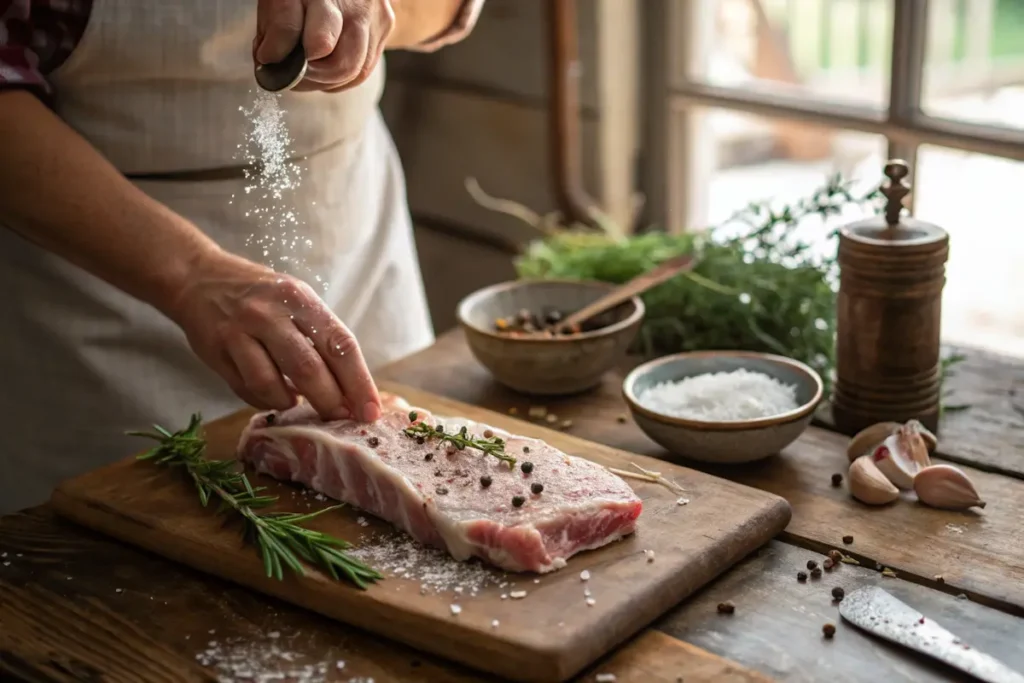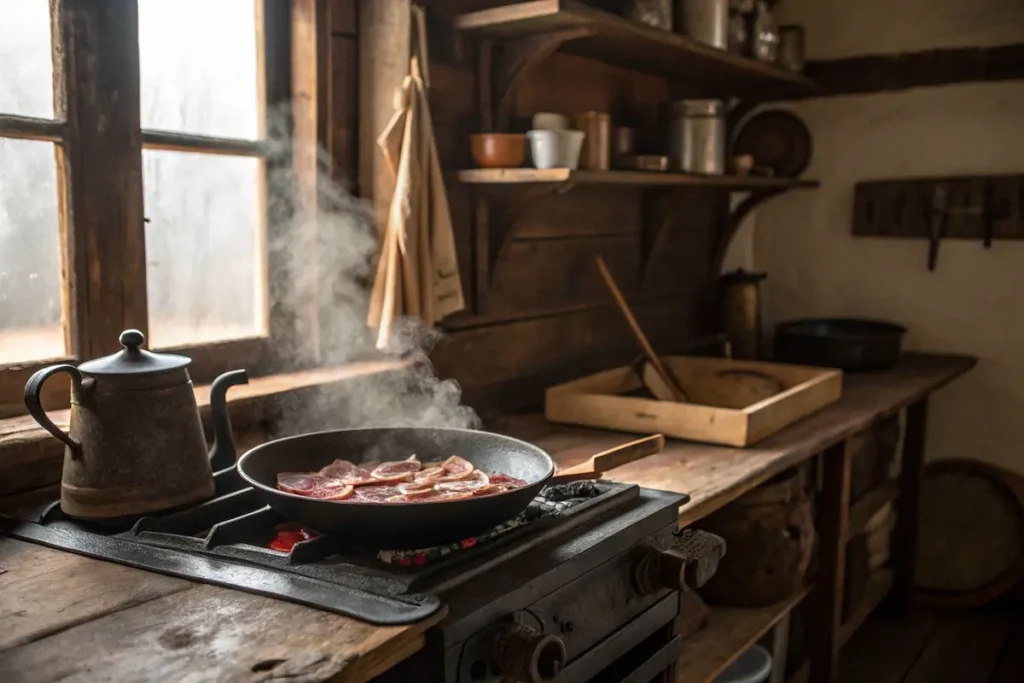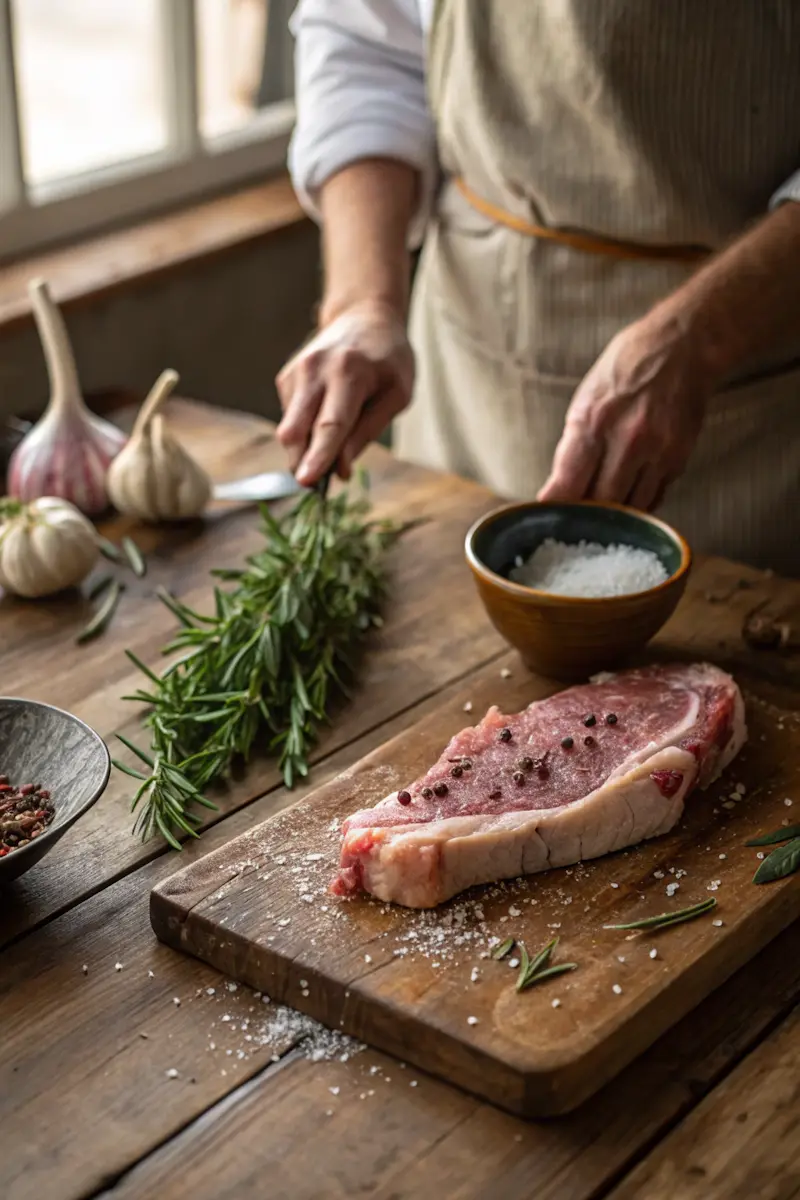Out on the edge of the Miller farm, when the air gets cooler and the smoke from the wood stove starts curling against the morning light, Jake starts thinking about guanciale. Not because it’s trendy or something he saw on a cooking show, but because he’s got a pig in the smokehouse and a jowl ready to be transformed.
Guanciale isn’t just a fancy cut of cured meat—it’s a farmhouse tradition that speaks of slow time, simple salt, and flavor that holds through every season. While most folks toss the jowl aside or grind it into sausage, Jake sees it for what it is: a rich, fat-laced masterpiece waiting for a little salt and patience.
Whether it ends up crisped on a skillet or tucked into a pot of beans, guanciale carries a kind of depth you can’t fake. And once you make it the farmhouse way, you’ll never look at bacon or pancetta the same again.
Let’s head into the farmhouse kitchen and see how Jake makes it, from start to hang.
What Is Guanciale?
A Cut That Knows Flavor Like a Story Knows an Ending
Guanciale comes from the cheek or jowl of the pig—a cut that doesn’t look like much at first glance. But if you ask Jake, he’ll tell you this little slab is pure gold. Packed with fat and just the right amount of muscle, it’s built for curing. Unlike pork belly, which gives you bacon or pancetta, guanciale’s fat is firmer, silkier, and richer once cured.
Cured right, it’s salt-forward with a subtle, earthy backnote—one that makes pasta dishes sing and brings soups and stews up a whole notch. Jake likes it sliced thin and crisped slowly, letting the rendered fat carry the rest of the dish.
Why the Jowl? Why Not Just Use Bacon or Ham?
This isn’t the kind of meat you rush. The cheek works harder than other parts of the pig, which means it packs more flavor into every bite. Jake’s cured jowl isn’t about showing off—it’s about honoring the animal, using every part, and creating something with patience.
Coming up next: the age-old debate around pancetta vs guanciale—and why Jake always reaches for the jowl first.
Great, let’s keep this story rolling.
What’s the Difference Between Guanciale and Pancetta?
Jake’s Take on the Great Cured Meat Debate
Around the Miller table, when the topic of cured meat comes up—and it does more often than you’d think—Jake makes one thing clear: guanciale isn’t pancetta, and it sure isn’t bacon. “They each got their place,” he’ll say, “but when you want real depth in a dish, you go with the jowl.”
Pancetta comes from the belly of the pig. It’s fatty, soft, and often rolled before it’s cured. It’s usually milder, sometimes even sweet depending on the cure. Guanciale, on the other hand, is bolder. The fat is denser, the flavor deeper, and when it hits a pan, it doesn’t just melt—it transforms.
Emily’s Kitchen Test: Pancetta vs. Guanciale
Emily once tried swapping pancetta into her carbonara because the butcher was out of jowl. The dish was fine—but it wasn’t magic. It lacked the richness, that buttery edge that guanciale gives without even trying. “It’s like baking biscuits with margarine,” she said with a shrug. “It’ll do, but it ain’t the same.”
So When Do You Use Guanciale?
Here on the farm, Jake uses guanciale in just about everything that calls for a cured pork product—except maybe breakfast, where he still reaches for old-fashioned bacon. But for pastas like Carbonara, Amatriciana, and Gricia, guanciale’s the only way to go.
And now that we know what makes guanciale different, let’s get into what really matters—how to make it, Miller-style.
Homemade Guanciale – The Farmhouse Way
Why Jake Swears By Making It Himself
Jake always says there’s something deeply satisfying about turning a humble cut of meat into something so flavorful it can transform a meal. Around the Miller farm, that cut is the pig’s jowl—and when it’s cured the right way, it becomes guanciale: rich, salty, peppery, and farmhouse-approved.
Most folks might shy away from jowl, but not Jake. “That’s where the magic lives,” he’ll grin, knife in hand. “It’s cheap, full of character, and once you’ve done it once, you’ll never look back.”
Emily’s Curing Corner
While Jake handles the prep and curing, Emily’s the one who keeps an eye on the flavorings. “It’s like pickling or canning,” she says. “Once you get the basics right, you can make it your own.” Her favorite blend? Garlic, rosemary, and just a hint of chili flake for kick.
Ingredients for Farmhouse Guanciale
- 1 whole pig jowl (skin on, glands removed)
- 3% of jowl’s weight in coarse salt (sea salt or kosher, never iodized)
- 1.5% cracked black pepper
- Extra ground pepper for coating after curing
- Optional flavors (Emily’s pick):
- 2 garlic cloves, crushed
- 1 sprig rosemary
- 1 tsp chili flakes
- 1 large zip bag or vacuum-seal bag
Jake’s Note: Ask your butcher for the fattier jowl they’ve got. Fat is flavor, and this cut’s all about it.
Learn more about other farmhouse curing tricks in our chicken pot pie casserole guide—because slow and low wins the flavor game every time.
Instructions – Jake’s Step-by-Step
Step 1: Prep the Jowl Like a Pro
Jake starts by leaving the skin on—keeps the shape tight during curing. He inspects the jowl for any glands, those squishy gray ovals nestled by the red meat. He uses a sharp paring knife to ease them out clean. Then he scorches off any stubborn hairs with a lighter or gives the skin a quick shave. After that, it’s a gentle rinse and a firm pat-down with a clean tea towel.
Step 2: Rub It Down with Salt and Love
Jake lays the jowl meat-side up in a dish and massages in the salt, cracked black pepper, and all those extras Emily picked out—garlic smashed under a knife, rosemary stripped off its stem, and a dash of chili flakes. Once the meat’s coated, he rubs the rest over the skin for good measure. No spice left behind.
Step 3: Bag It Up and Let Time Work Its Magic
Into a ziplock it goes, cure and all. Jake presses out the air by sinking the bag in water—his homemade vacuum seal trick. Then he seals it tight and gives it one more firm press, just to settle the mix in.
Step 4: Refrigerate and Flip It Daily
The bag heads to the fridge, skin side up. For 5–7 days, Jake checks on it every morning while the coffee brews. Each day, he gives it a gentle massage through the bag and flips it over. If it’s a big jowl, closer to a kilo, he lets it ride the full 7 days.
Step 5: Don’t Drain That Liquid
By day three, the cure draws out moisture, creating a natural brine. Jake never pours it off. “That’s flavor soaking back in,” he says. The jowl darkens, firms up, and smells like something real good is happening.
Step 6: Rinse, Dry, and Peppercoat
Once curing’s done, Jake rinses the jowl under cool water, just enough to remove excess cure—not scrubbing, just rinsing. Then he pats it bone-dry and dusts the whole thing with ground black pepper, pressing it gently into the surface.
Step 7: Hang It and Forget It (Mostly)
With the skin on, one end of the jowl is always thinner. Jake pierces that end and threads kitchen twine through to make a loop. Then he hangs it in a cool, dark pantry or shed—anywhere between 50–65°F (10–18°C). No direct sunlight. No need to overthink it.
Step 8: Wait Five Weeks (At Least)
This is the part Jake calls “the patience cure.” The guanciale hangs for a good 5 weeks, longer if it’s chilly or if he’s after a more intense flavor. The fat doesn’t lose much moisture, but the red meat shrinks and firms. That’s when he knows it’s ready.
Step 9: Slice as You Need It
Jake cuts what he needs, thin or thick, depending on the dish. Skin on or off? Depends on the recipe. Most times he leaves it—gives a better sear in the pan. The rest goes back in the fridge or gets rehung until next time.

Emily’s Favorite Ways to Cook with Guanciale
Guanciale in the Miller Kitchen – Simple, Savory, Unforgettable
When the guanciale’s finally ready and Jake slices into that first piece—just thin enough to see the light peek through—Emily’s already thinking about what’s for dinner. Around their table, guanciale doesn’t need a fancy title to shine. It’s comfort food with deep flavor, the kind that turns everyday meals into something worth remembering.
Carbonara, the Real Deal
Emily doesn’t mess with cream in her carbonara. She follows the old Roman way—egg yolks, Pecorino Romano, black pepper, and guanciale. That’s it. The fat renders slow in the skillet, the aroma rich and smoky. Then in goes the pasta and that glossy sauce. Jake says it tastes like Rome met the farm and decided to stay.
Crispy Bits on Roasted Veggies
When root vegetables come out of the garden—carrots, parsnips, maybe a few stubborn beets—Emily dices up a handful of guanciale and tosses it right on the sheet pan. The fat melts, coats everything in smoky flavor, and crisps up in little golden nuggets. It’s her sneaky way of making vegetables disappear off the plate.
Guanciale & Black Garlic with Cherry Tomatoes
Sometimes she gets fancy and follows a favorite from a friend across the pond—guanciale with black garlic and sweet cherry tomatoes. The guanciale renders down, the garlic melts into it, and the tomatoes blister and pop. Toss it with fresh pasta or spoon it over polenta—it’s good either way.
Breakfast Hash, Miller Style
On slow Sundays, Emily chops guanciale thick, browns it in a cast iron pan, then throws in diced potatoes and onions. A couple of eggs cracked on top and finished in the oven makes a skillet full of smoky, crispy, golden comfort. Even Lucky waits patiently by the stove on those mornings.
Emily’s Tip: Save the Rendered Fat
She never lets the guanciale fat go to waste. After cooking, it’s strained and saved in a jar for later—perfect for sautéing greens, starting soups, or brushing over cornbread before baking.

Emily’s pasta doesn’t stop here. Discover how she builds sauces in our buffalo mozzarella recipe with farmhouse charm.
FAQs: All About Guanciale
Does guanciale taste like bacon?
Jake says it’s like comparing a campfire to a candle. While guanciale and bacon both come from pork, guanciale packs a richer, deeper flavor thanks to the way it’s cured and aged. It’s got more porky character, less smoke, and a melt-in-your-mouth texture that bacon just can’t match. Around the Miller kitchen, it’s the star in carbonara, where its fat turns to pure gold in the pan.
Why is guanciale banned?
In some countries, particularly the U.S., importing guanciale can be tricky due to regulations around cured meats and food safety. Jake remembers Emily trying to bring some back from a trip to Rome—and let’s just say airport security had other ideas. But making your own at home? That’s the farmhouse workaround they now swear by.
Is guanciale pork or beef?
It’s 100% pork. Specifically, it comes from the jowl—or cheek—of the pig. Jake’s butcher always says it’s one of the most overlooked cuts, but in Italian kitchens (and now the Miller’s), it’s the prized part for curing into guanciale. Rich fat, deep flavor—it’s the kind of thing that makes everything taste better.
Can I substitute pancetta or bacon for guanciale?
You can, but it won’t be quite the same. Jake’s tried them all, and while pancetta comes close, it lacks the silky fat and intense flavor of true guanciale. Bacon’s smokier and leaner, which changes the balance in recipes like carbonara or amatriciana. When in doubt, Jake says: “If you can’t find it, make it!”
How do you store homemade guanciale once it’s cured?
After curing and drying, Jake hangs his guanciale in the pantry or keeps it wrapped in parchment in the fridge. It’ll last weeks, sometimes months if you treat it right. Just slice off what you need, and rewrap the rest. Jake calls it ‘charcuterie on demand’—always ready for the skillet.
Just like we do in our baby back rib breakdown, let’s bust myths about pork cuts the farmhouse way.
Final Thoughts from the Farmhouse
Out on the Miller farm, guanciale isn’t just a slice of cured meat—it’s a story. A story of not wasting a single part of the pig, of leaning into tradition, and of turning simple cuts into something unforgettable. Jake always says there’s magic in taking time, and guanciale proves it: no rush, no shortcuts—just salt, patience, and a little know-how.
Whether you’re curing your first jowl or adding it to Emily’s pasta alla gricia on a Sunday night, guanciale brings flavor that’s bold, honest, and rooted in something old and good. It’s the kind of food that reminds you where you came from—even if you’re a few thousand miles from the hills of Lazio.
So the next time you see a pork jowl at the butcher’s counter, don’t walk past. Pick it up. Cure it like Jake does. Hang it. Wait for it. And when the time comes, slice it thin and let the fat melt in the skillet. That’s when you’ll know—it was all worth it.
From the Miller kitchen to yours, happy curing. And may your farmhouse always smell like something good’s about to happen.
—Jake, Emily & Lucky the Dalmatian
For more cozy comfort food stories, check out Jake’s detailed method in how to cook jasmine rice—because even side dishes deserve slow-crafted care.
Table of Contents
Guanciale: How To Make the Secret to Flavorful Cured Meat
Farmhouse-style guanciale made from pork jowl, cured with salt, pepper, and herbs—an old-world technique passed down on the Miller farm.
- Prep Time: 30 minutes
- Cook Time: 0 minutes
- Total Time: 5 weeks
- Yield: 1 cured jowl 1x
- Category: Charcuterie
- Method: Curing
- Cuisine: Italian, Farmhouse
Ingredients
- 1 whole pig jowl (skin on, glands removed)
- 3% of jowl’s weight in coarse salt (sea salt or kosher, never iodized)
- 1.5% cracked black pepper
- Extra ground pepper for coating after curing
- Optional flavors:
- 2 garlic cloves, crushed
- 1 sprig rosemary
- 1 tsp chili flakes
- 1 large zip bag or vacuum-seal bag
Instructions
- Inspect jowl, remove glands, and clean the skin with a quick scorch or shave.
- Rinse and pat dry thoroughly.
- Massage salt, pepper, garlic, rosemary, and chili flakes into the meat and skin.
- Place the jowl into a ziplock or vacuum bag, press out air, and seal tightly.
- Refrigerate skin side up for 5–7 days, flipping and massaging daily.
- Don’t discard the liquid drawn out during curing—it reabsorbs flavor.
- After curing, rinse lightly, pat dry, and coat with ground black pepper.
- Loop twine through thinner end and hang in a cool (50–65°F), dark place for 5+ weeks.
- Slice as needed for cooking, keeping the rest refrigerated or re-hung.
Notes
Ask your butcher for a fatty jowl—fat is key for flavor. After curing, the guanciale can be stored wrapped in parchment in the fridge for weeks.
Nutrition
- Serving Size: 20g
- Calories: 150
- Sugar: 0g
- Sodium: 420mg
- Fat: 13g
- Saturated Fat: 5g
- Unsaturated Fat: 7g
- Trans Fat: 0g
- Carbohydrates: 0g
- Fiber: 0g
- Protein: 7g
- Cholesterol: 25mg


